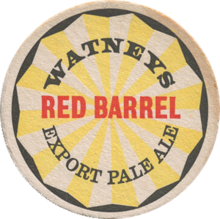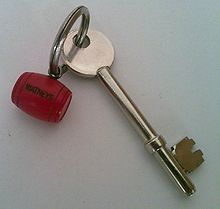- Watney Combe & Reid
-
Watney Combe & Reid Industry Brewing Fate Acquired Predecessor The Stag Brewery Successor Watney Mann Founded 1837 Defunct 1958 Headquarters London, United Kingdom Products Beer Watney Combe & Reid was a leading brewing business in London. At its peak in the 1930s it was a constituent of the FT30 index of leading companies on the London Stock Exchange. It produced the beer brand Watney's Red Barrel.[1]
Contents
The Stag Brewery
The Watney family were the main partners in the Stag Brewery, Pimlico, for much of the 19th century.[2] In 1837 James Watney became a partner in the brewery, as did his sons James and Norman in 1856.[2] On his death in 1884, the brewery became a private limited company.[2]
In 1898 it acquired Messrs. Combe Delafield and Co. and Messrs. Reid and Co., and was thereafter known as Messrs. Watney Combe and Reid.[2]
Combe Delafield and Co.
Combe Delafield and Co. was one of the major brewers in London during the nineteenth century, before being acquired by Watney in 1898, thus forming Watney Combe and Reid.
The Woodyard Brewery, of Castle Street, Long Acre, situated midway between the City and the West End of London, took its name from the original occupation of Thomas Shackle, a dealer in timber, who founded it in 1740. Shackle is said to have delivered his beer in small casks with his wood and he soon built up a valuable business. He was succeeded by a Mr. Gyfford, of whom no further record remains. At the beginning of the 19th century the brewery was acquired by Harvey Christian Combe, who was remarkable for his energy and great business ability.[3] Combe had been Lord Mayor of London in 1799-1800 and was Member of Parliament for the City of London from 1796 to 1817.
The business was largely increased under the management of Combe, who repaired and rebuilt the brewery premises. On his death in 1832 the brewery passed to his son, Harvey Combe, and his brother-in-law, Joseph Delafield, by whom the premises were further enlarged. Harvey Combe, who was a great sportsman and well-known as the master of the Berkeley Hounds, died unmarried in 1858. He was succeeded by his two nephews, Messrs. R. H. and Charles Combe, Mr. Joseph Bonsor and his two sons, and Mr. John Spicer. Under the management of these partners, the brewhouse property was still further extended, and ultimately covered more than 4 acres (16,000 m2).[3] The water, or "liquor" as the brewers term it, required for brewing purposes was supplied in part by the New River Company and partly by three deep wells sunk by the firm upon the premises.
In 1834, the company was involved in two major strikes. The first, in March, involved the coopers who were demanding an increase in their wages; part of their tactics involved persuading other workers to boycott the company's beer. Although this strike petered out, it set a precedent. In April, the following single line article appeared in The Times: "The carpenters and bricklayers belonging to the Trades Unions have, in consequence of Messrs. Combe and Delafield's refusal to employ any person connected with Trade Unions, resolved to drink no more of their beer" (The Times, 5 Apr 1834).[4]
In July, the Master Builders proposed the reduction in the wages paid to the journeymen and to refuse to employ members of the Operative Builders' Union. Amongst the Master Builders concerned were Lewis and William Cubitt, brothers of Thomas Cubitt, who had workshops on the Gray's Inn Road. The brothers had had long-standing connections with the brewery, being responsible for the construction of a number of its pubs. In return for these profitable contracts, the brothers prohibited the consumption of any beer in their workshops, other than that brewed by Combe Delafield. The unions called for a boycott of the brewery culminating on 26 July 1834 in a meeting at the Silver Cup public house, when an extraordinary resolution was passed, "that all workers in the metropolis are urged to stop drinking beer produced by the Combe and Delafield brewery".[4] The dispute continued until November, with neither side achieving much. The biggest losers were possibly Combe Delafield who, despite being innocent victims of the dispute, suffered heavy losses through reduced beer sales.
Originally, the brewery's main product had been the dark porter style of beer. In 1818 it was the fifth largest brewer of Porter in London, producing over 130,000 barrels (21,000 m3) a year.[5] By the middle of the 19th century, following the Great Exhibition lighter ales were becoming more popular. According to "The Red Barrel: a History of Watney Mann", by Hurford Janes (1963) "at the Wood Yard Brewery Combe, Delafield & Co, quickly adjusted their methods to meet the new demand, brewing ales similar in colour and flavour to those of Burton ale which had become the rage".[6]
In 1866, the company changed its name to "Combe & Co." By the late 19th century, the senior partner in the brewery was Joseph Bonsor's son, Sir Cosmo Bonsor, who organised an amalgamation of Combe & Co. and Reid and Co. with the Watney brewery, to form Watney Combe & Reid, of which he remained chairman until 1928.
Watney Mann
Watney Mann was formed in 1958 with the merger of Watney, Combe, Reid & Co. Ltd with Mann, Crossman & Paulin Ltd. The business acquired other brewers, including Phipps NBC of Northampton and Ushers of Trowbridge, before merging with Grand Metropolitan Hotels in 1972, and closed in 1979.[7]
Watneys Red Barrel
Watneys Red Barrel was a bitter popular in the United Kingdom in the 1960s and 1970s and is referenced as a cultural phenomenon of that era,[8][9] such as in the Monty Python "Travel Agent" sketch.[10] and the BBC series "Life on Mars" Series One episode three. It was introduced in 1931 as an export keg beer that could travel for long distances by being made stable through filtering and pasteurising - as such it was the first keg beer.[8] In 1986, Biederman & Company was chosen as the advertising and public relations firm for Watneys.[1]
The beer could be purchased in cans called the Party Seven and Party Four (at seven and four pints, respectively), introduced in 1968.[8][11]
A 3.9% abv pale lager with the name Watneys Red Barrel was sold by the Sleeman Brewery until 1997[12] and a 6.0% beer with the same name is still brewed by Alken-Maes [13]
References
- ^ a b Dougherty, Philip (1986-10-23). "Biederman Is Named For Watney Red Barrel". The New York Times.
- ^ a b c d British History on-line
- ^ a b "A History of the County of Middlesex: "Industries: Brewing"". www.british-history.ac.uk. http://www.british-history.ac.uk/report.aspx?compid=22171. Retrieved 8 March 2008.
- ^ a b ""Masters of their own throats": the 1834 beer strikes". breweryhistory.com. http://breweryhistory.com/journal/archive/114/bh-114-022.html. Retrieved 8 March 2008.
- ^ "Quantity of Porter brewed - 1817 & 1818". www.londonancestor.com. http://www.londonancestor.com/leighs/mar-ale.htm. Retrieved 8 March 2008.
- ^ "Barclay Perkins". barclayperkins. http://barclayperkins.blogspot.com/2007/12/london.html. Retrieved 8 March 2008.
- ^ Directory of UK Real Ale Breweries
- ^ a b c "Watneys Red Barrel". RetroWow. http://www.retrowow.co.uk/retro_britain/keg_bitter/watneys_red_barrel.html. Retrieved 2008-06-25.
- ^ "Critics' choice". The Sunday Times. 2002-09-01. http://search.ebscohost.com/login.aspx?direct=true&db=nfh&AN=7EH1564609480&site=ehost-live. Retrieved 2008-06-25.
- ^ "Travel Agent / Watney's Red Barrell". www.orangecow.org. http://www.orangecow.org/pythonet/sketches/package.htm. Retrieved 2009-07-13.
- ^ Turnbull, Tony (2007-07-07). "Roll out the barrel". The Times.
- ^ "Watneys Red Barrel from Sleeman Brewing & Malting Co. (Sapporo) - Ratebeer". ratebeer.com. http://ratebeer.com/beer/watneys-red-barrel/4163/. Retrieved 2009-07-13.
- ^ "Belgian Beers - Belgium Travel Guide - Eupedia". eupedia.com. http://www.eupedia.com/belgium/belgian_beers.shtml. Retrieved 2011-02-21.
External links
 Original companies of FT 30 in the United Kingdom
Original companies of FT 30 in the United KingdomAs of 1 July 1935.
Associated Portland Cement · Austin Motor · Bass · Bolsover Colliery · Callenders Cables & Construction · Coats · Courtaulds · Distillers · Dorman Long · Dunlop Rubber · Electrical & Musical Industries · Fine Spinners and Doublers · General Electric Company · Guest Keen & Nettlefolds · Harrods · Hawker Siddeley · Imperial Chemical Industries · Imperial Tobacco · International Tea Co. Stores · London Brick · Murex · Patons and Baldwins · Pinchin Johnson & Associates · Rolls-Royce · Tate & Lyle · Turner & Newall · United Steel Companies · Vickers-Armstrongs · Watney Combe & Reid · F. W. Woolworth & Co
Categories:- Brewing in London
- Defunct brewery companies of the United Kingdom
- Companies formerly listed on the London Stock Exchange
- Companies established in 1884
- Companies based in London
- Companies disestablished in 1972
Wikimedia Foundation. 2010.


